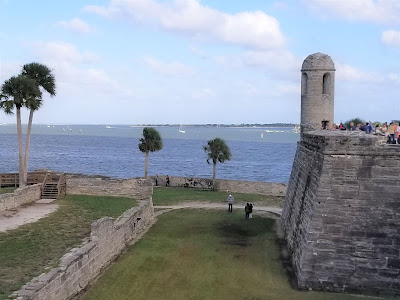Saturday November 9, 2019
We hopped
off the trolley by the Pirate Museum and began to tour.
The Pirate museum called to us and we entered
to explore the Golden Age of Piracy beginning with Port Royal. The
museum claims to have the largest collection of authentic pirate artifacts
dating back to the 10th century.
It has one of the three original Jolly Roger flags and an authentic
pirate treasure chest. A display on navigation at the time starts the
experience. Then a display of firearms
comes next.
Sometimes
we forget that Sir Francis Drake was a pirate. Archaeologists have unearthed
evidence of a pirate siege from Market Street that shows it was part of Drake’s
raids.
This
room is called the Rogues Tavern and introduces several pirates. This diorama speaks to the fact that these two pirates probably never met, but
legends of the two have been told.
Games of
chance helped entertain the sailors at sea.
This section of the museum was to look like a pub. It also included video boards where guests
could interact on a pirate mission of they wanted.
The next
room resembled a ship’s deck. A compass
from the 17th century.
The
ship’s bell was part of an exhibit on telling time.
This
interactive exhibit let you learn how to tie a variety of knots needed for
sailing. Derrille did very well with his
knot tying ability.
The
captain stands over some cargo crates that should smell like what they
carry. However, my incredible sense of
smell didn’t pick up much. Maybe the
scents need refreshing.
On the
Gun Deck you get to fire the cannons. You touch the stick to the top of the gun
and it goes KA-BAM! Very Noisy! I enjoyed firing
the cannons several times!
The door
at the back leads you into a windowless room where you put on a headset and
experience being below decks.
Several
pirate’s bios were highlighted.
When I
came around the corner and Blackbeard's head began speaking it gave me a little bit of
a chill.
The captain’s cabin held interesting things. The authentic Jolly Roger flag, the spyglass
and rosary, and the captain in his bunk.
The
captain could be seen breathing, as his chest rose and fell. Just a tad spooky.
I found
it interesting to discover that life aboard a pirate ship was democratic. A strict code of conduct was enforced.
The next
section Shipwreck Island showed pirate artifacts.
More
recovered treasure pieces.
An authentic Pirate’s
Chest.....so they say.
The last
room held movie poster and things of pirate movies.
Capt.
Jack Sparrow’s sword.
What a
fun museum!
After
lunch and a stroll down St. George Street we headed to the fort.
Castillo de
San Marcos had ground broken for its construction in 1672 but wasn’t completed
until 1695. It stayed under Spanish rule
until 1763 when the Peace of Paris gives Florida to Great Britain. After the Revolutionary War, the United
States returned Florida to Spain. 1821 Spain cedes Florida of the United
States. In 1935 the National Park
Service took over administration of Castillo de San Marcos and Fort Matanzas
south of St. Augustine.
The entry
moves over the grass moat. During sieges the mote held domestic animals. The
moat could be flooded by opening a gate on the seawall.
Originally
the heave grated gate could also be protected by a system of two drawbridges.
St.
Augustine’s was considered a garrison town or presidio. No one lived in the
fort, they just came to stand guard, usually for 24 hours. So they slept and prepared their meals in
these rooms.
Views from the top of the fort looking back toward old town and out to sea.
Looking down into the fort.
This
represents an excellent look at coquina wall material.
We
started our tour on top of the fort. We
happened to arrive in time to see a cannon firing demonstration.
Weapons
on the gun deck.
The
design of the fort added to its ability to defend. The star shape allowed a
battery of cannons to create interlocking fields of fire.
This volunteer gave us information about the tools needed to fire the cannon.
This cannon shows the detail used to put the crest of arms on it.
Other costumed interpreters were a trove of information.
The rooms
on the main floor of the fort held a variety of displays. Some were used for storage rooms.
One
showed close quarters for four soldiers. The white boards form a bunk bed for four.
The
church held an important part of the fort lifestyle. The remains of the church
area were interesting to me. The holy water font still has parts of it in the
wall. Examples showed uses for services
and schooling.
Here is
artist’s portrayal of how the church could have looked.
Several
people were honored throughout the rooms as the story of the fort unfolded.
Father Lopez e Mendoza Grajales we know said the first Mass in St.
Augustine. Some tell stories of Indians, military, powerful women, etc.
Others
rooms talked about construction of the fort, restoration and other historically
significant events regarding the fort and St. Augustine.
We had an
enjoyable visit to the fort. Tomorrow Anastasia Island, just across the bridge.













































































































No comments:
Post a Comment